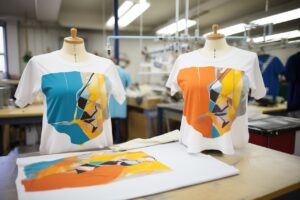Implementing a rock-solid quality-control system is key to making apparel decorating production problems go away
There’s an old saying: “Doctors bury their mistakes. Lawyers put theirs in jail. But journalists put theirs on the front page for all the world to see.” Alas, the same can be said for custom apparel decorators. Worse yet, while it doesn’t take long for even the worst typo to become old news, decorated apparel is forever, making the standards by which the industry is now held higher than ever. Bottom line, to make it in today’s world you can’t just produce junk.
What follows are some tips for upping your quality control game with an eye toward ensuring you and your company make the grade. Look for more quality control tips in Part 2 of this two-part series.
“One of the beautiful things about the decorated apparel industry is there aren’t a lot of barriers to entry,” says Rodney McDonald, president at US Colorworks (uscolorworks.com). “That builds an entrepreneurial spirit and keeps things fresh.”
The flip side of this coin, though, McDonald says, is you get a lot of shops that start as hobbyists, and they don’t always approach their work with the same level of intent as running a business.

As smaller, newer shops begin to grow, they invariably find it necessary to employ a more systemic approach to quality control. Image by andrew_shots – stock.adobe.com
McDonald and his business partner, both with manufacturing backgrounds, approached their shop with a unique perspective. They built their business—which now prints about 30,000 shirts daily—by prioritizing actual manufacturing over many typical T-shirt shop practices.
He says this kind of distinction in an owner’s mindset can make a huge difference to a shop’s longevity and bottom line, for the simple reason that manufacturers think about processes and flow, including quality control, whereas all too many print shops out there focus on tackling one job at a time.
With this in mind, an effective quality control (QC) program represents a systematic process used in manufacturing and production to ensure every product meets a specific set of quality standards before reaching the customer. A solid QC process involves monitoring various aspects of the production process, detecting and correcting defects, and ensuring the final product conforms to the required specifications.
To find out how today’s top shops consistently deliver perfect prints, I checked in with some industry pros to learn a little bit about their QC methods and how other shops can implement them to up their game as well. In screen-printing and embroidery shops, the goal should be to deliver a product that meets or exceeds customer expectations and reduces the likelihood of returns or complaints. The following tips will go a long way to ensuring you do, not just most of the time, but with each and every order.
1. Setting your decorated apparel shop’s standards
As a first step toward implementing an effective quality-control program, whether yours is a brand-new or veteran shop, consider whether you’ve ever really, mindfully tried implementing a QC process in the past. “A tested QC process is important for a shop of any size, because we’re the last ones to touch the product before the customer sees it and before the person wearing it puts it on,” McDonald says. “If you put out a flawed product, it’s such a hard thing to recover from—you look bad, your customer looks bad, and you lose the order. There’s a cost to establish a robust QC process, but the cost of failure is significantly higher.”
As part of this process, ask yourself whether you’ve ever really defined what “acceptable quality” means for your shop and its products? If not, this is an important first step. Establishing clear quality standards ensures that every aspect of the product meets your expectations from start to finish.

Among the challenges when it comes to quality control is ensuring employees recognize the importance of high standards. Image by studioworkstock – stock.adobe.com
“That encompasses everything, from getting the art right to getting the print straight, to curing or sewing it properly,” says Marshall Atkinson, a business consultant at Atkinson Consulting (atkinsontshirt.com) and publisher of the AI e-newsletter, Midjourney Experience (midjourneyexperience.com). Simple mistakes, like printing “2024” when the customer wanted “2025,” can be costly and frustrating, so build attention to detail throughout the process.
With this in mind, at Stakes Manufacturing (stakesmfg.com), co-founder Jed Seifert says all decorated products at his shop receive multiple QC checks over the course of the entire product lifecycle, from receiving garments to shipping finished products.
“We have a proprietary file prep process that allows us to Pantone match and consistently hit color accuracy standards,” Seifert says. “We linearize our presses and do regular preventative maintenance to ensure print consistency across our equipment fleet. We thoroughly test and profile garments to the SKU level across all printing systems.”
Yes, it’s embarrassing when a customer sends you a picture of a shirt with issues. “But that’s why it’s important to develop your QC process, no matter the size of your shop, and you’ll be able to grow,” says Keith Burwell, owner of Precision 1 Concepts (precision1koncepts.com). “That way, you can take pride knowing you do your best to ensure quality products leave your shop.”
2. Understanding custom-apparel customer expectations
When it comes to QC and print shops, it all starts with understanding customers’ expectations. This can be tricky, because the customer might not always know exactly what they want either—that or they may have higher standards than you expect. “This means having open conversations with your client about their priorities so you can focus on delivering the things that matter most to them,” Atkinson says.
As an example, if a customer asks for a specific color, your final product must match that shade. “If they ask for royal blue ink on a white shirt, does it match the Pantone color they expect?” says Atkinson, noting missing this step leads to unhappy customers. To address these kinds of problems, he recommends using things like Pantone color books or a color spectrometer to maintain accuracy.
Another part of QC is educating your customers as to what’s possible. “Often, customers don’t fully understand the production process,” Atkinson says. “So, clearly explain what you can deliver so everyone’s on the same page.”
Echoing this sentiment, contract decorator US Colorworks’ McDonald says his company will often take its customers on shop tours as part of its sales and marketings efforts.
“By demonstrating our process and inviting people to see our facility, we showcase the infrastructure dedicated to quality,” McDonald says. “This becomes a huge selling point, because our clients, primarily distributors, invest time and energy selling to their clients.”
The other factor McDonald says his company considers is the long-term or lifetime value of a customer, especially in those instances where you find yourself not making money or possibly even taking a loss on a job as a result of QC errors.
“As you document and do research, keep track of whether a lot of these errors are occurring because this one customer isn’t communicating effectively,” he says. He adds there are times decorators “must educate…customers since they’re not printing experts. We might say, ‘This job would be better with a different printing technique or garment.’’’
Note, there are times this kind of analysis may mean parting ways with some clients. “There are some customers you can’t afford to do business with because they’re not organized enough to communicate effectively,” McDonald says. “We’ve had to tell customers a different printer might better serve them, and some have even returned, saying, ‘You were right.’”
3. Automation, technology and quality assurance in custom apparel decorating
According to Stakes’ Seifert, his company’s quality-control process combines the efficiency of technology and the precision of manual tools, supported by a team of experienced professionals who undergo thorough training and education. Again, his shop’s products receive multiple QC checks over the course of the decorating process, during receiving, staging, pre-production and post-production, as every item is QR-coded and scanned at every touchpoint, with screens showcasing product mock-ups and product/garment details.
“We report internal QC fails in real time to isolate and resolve any equipment and human errors,” Seifert says. “Every order is meticulously tracked throughout the production, QC and fulfillment processes, allowing us to identify the root cause and trends of quality issues. We address all individual instances where items are shipped without meeting our quality standards. In such cases, we provide corrective training to the responsible employees. This approach ensures we consistently deliver high-quality products while fostering a continuous improvement culture.”
Automating the ordering process, in particular, can help ensure smoother operations and more straightforward customer communication, since shops can both streamline production and set clear expectations by having systems to guide customers through the specifics of order entry.
“Our systems ask the questions as customers input their information,” McDonald says. “When customers receive a proof, it includes their timeline. Setting these expectations is important because it keeps customers informed about what to expect at each step of the process.”
For smaller shops that don’t yet have the resources for this kind of automation, McDonald suggests creating a similar manual approach. “If you’re not big enough to do automation, have a list of questions you want to ask for every order,” he says. “Have a process for order entry and order taking early on to prevent problems and manage expectations effectively.”
By way of an example, while the Precision 1 Concepts team uses shop management software to track orders, it also relies on paper checklists to ensure accuracy from start to finish. “We still use paper check-off sheets from receiving and shipping and into production start to finish,” Burwell says. The resulting blend of digital and manual systems allows the shop to maintain tight control over timelines and production.
4. Developing specific apparel decorating processes
As part of its production processes, US Colorworks operates a highly structured and thorough QC program. “Every time a person touches a step in the process, there needs to be quality control to verify that step was executed correctly,” McDonald says. For example, the team sends an art proof to customers for every order—even for repeat jobs—to prevent mistakes when selecting the correct artwork from a client’s portfolio.
Additionally, McDonald says his production team relies heavily on visual aids. “When our production people print garments, either digital or traditional screen print, there’s a visual of exactly what that product should look like on a screen next to their operating position,” he says. “Our operators and supervisors sign off on each order, ensuring that there are always two signatures for verification.”
In addition, he says, every US Colorworks operator can stop a job if something seems off. “Any of our operators can pull a garment or a job for a quality reason,” McDonald explains, emphasizing the fact the ability to do so is not limited to supervisors or managers. “We encourage people to ask questions. That’s what quality control comes down to—forcing yourself to ask questions when something doesn’t seem right.”
The resulting open culture of responsibility enables the team to catch and correct errors quickly, leading to fewer issues and a higher quality standard for each order, McDonald says, noting the processes for QC in screen printing and embroidery differ due to the unique nature of each method. “For screen printing, a lot of our quality control checks will come down to the following: Are we using the correct PMS colors for the ink?” he says. “Or did the ink get mixed correctly? Are we putting the decoration on the right garment?”
McDonald also emphasizes the importance of following a “recipe” for each job, including everything from the order of the screens being used things like squeegee angles or the pressure that need to be applied. “Our goal is to be able to print a shirt today, tomorrow, six months from now or five years from now, and it’s the same result every time,” he says, noting the fact that approximately 20 percent of his business comes from reorders only underscores the need for consistency.
Along these same lines, Precision 1 Concepts’ Burwell says that when it comes to embroidery work his company limits thread colors for efficiency. “We’ve developed our most popular thread colors and try to stay with those unless a customer requires something different,” he says. “We have three shades of red in stock vs. 15, but only our primary stays on the machine all the time.”
Conclusion: Quality control is central to profitable apparel decorating
Ultimately, an effective quality-control process plays a key role in determining the output from your facility, directly impacting client and customer satisfaction.
“Quality is not only a representation of your company but an extension of the brand, company or person you’re printing for, which is a responsibility that shouldn’t be taken lightly,” Seifert says.
Focusing on quality enhances your reputation while building strong, lifelong customer relationships, which can’t help but be a plus for you business.
Nicole Rollender is an award-winning writer and heads up the copywriting and content-creation firm Strand Writing Services. strandwritingservices.com. For more information or to comment on this article, go to strandwritingservices.com. For Part 2 of this two-part series, click here.
Updated 4/24/25





